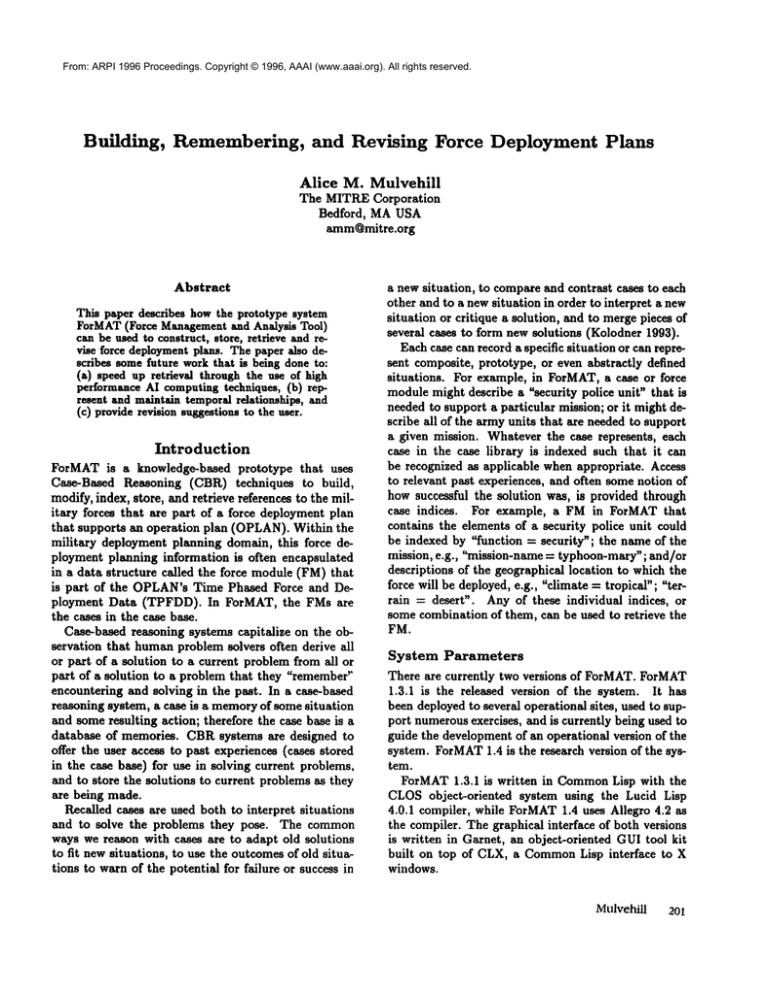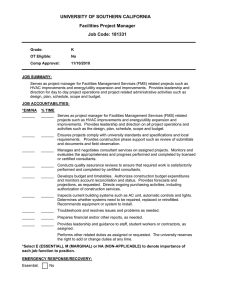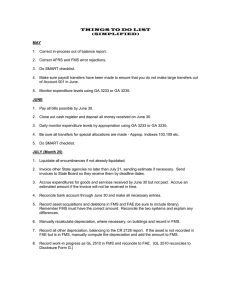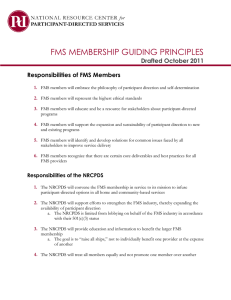
From: ARPI 1996 Proceedings. Copyright © 1996, AAAI (www.aaai.org). All rights reserved.
Building,
Remembering, and Revising
Force Deployment Plans
Alice M. Mulvehill
The MITRE Corporation
Bedford, MAUSA
amm@mitre.org
Abstract
This l~per describes howthe prototype system
ForMAT(Force Managementand Analysis Tool)
can be used to construct, store, retrieve and revise force deploymentplans. The paper also describes somefuture workthat is being done to:
(a) speed up retrieval through the use of high
performance AI computing techniques, (b) represent and maintain temporal relationships, and
(c) provide revision suggestions to the user.
Introduction
ForMATis a knowledge-based prototype that uses
Case-Based Reasoning (CBR) techniques to build,
modify, index, store, and retrieve references to the military forces that are part of a force deployment plan
that supports an operation plan (OPLAN).Within the
military deployment planning domain, this force deployment planning information is often encapsulated
in a data structure called the force module (FM) that
is part of the OPLAN’sTime Phased Force and Deployment Data (TPFDD). In ForMAT, the FMs are
the cases in the case base.
Case-based reasoning systems capitalize on the observation that human problem solvers often derive all
or part of a solution to a current problem from all or
part of a solution to a problem that they "remember"
encountering and solving in the past. In a case-based
reasoning system, a case is a memoryof some situation
and some resulting action; therefore the case base is a
database of memories. CBRsystems are designed to
offer the user access to past experiences (cases stored
in the case base) for use in solving current problems,
and to store the solutions to current problems as they
are being made.
Recalled cases are used both to interpret situations
and to solve the problems they pose. The common
ways we reason with cases are to adapt old solutions
to fit new situations, to use the outcomes of old situations to warn of the potential for failure or success in
a new situation, to compare and contrast cases to each
other and to a new situation in order to interpret a new
situation or critique a solution, and to mergepieces of
several cases to form new solutions (Kolodner 1993).
Each case can record a specific situation or can represent composite, prototype, or even abstractly defined
situations. For example, in ForMAT,a case or force
modulemight describe a "security police unit" that is
needed to support a particular mission; or it might describe all of the army units that are needed to support
a given mission. Whatever the case represents, each
case in the case library is indexed such that it can
be recognized as applicable when appropriate. Access
to relevant past experiences, and often some notion of
how successful the solution was, is provided through
case indices.
For example, a FM in ForMATthat
contains the elements of a security police unit could
be indexed by "function = security"; the name of the
mission, e.g., "mission-name = typhoon-mary"; and/or
descriptions of the geographical location to which the
force will be deployed, e.g., "climate = tropical"; "terrain = desert". Any of these individual indices, or
some combination of them, can be used to retrieve the
FM.
System
Parameters
There are currently two versions of ForMAT.ForMAT
1.3.1 is the released version of the system. It has
been deployed to several operational sites, used to support numerousexercises, and is currently being used to
guide the development of an operational version of the
system. ForMAT
1.4 is the research version of the system.
ForMAT1.3.1 is written in CommonLisp with the
CLOSobject-oriented
system using the Lucid Lisp
4.0.1 compiler, while ForMAT1.4 uses Allegro 4.2 as
the compiler. The graphical interface of both versions
is written in Garnet, an object-oriented GUItool kit
built on top of CLX, a CommonLisp interface to X
windows.
Mulvehill
201
From: ARPI 1996 Proceedings. Copyright © 1996, AAAI (www.aaai.org). All rights reserved.
ForMATruns on Sun Workstations,
with ForMAT
1.3.1 running under both (Sun OS 4.1.x) and Solaris
2.x, and ForMAT1.4 running only under Solaris 2.x.
ForMATrequires 130 megabytes of disk space (primarily to store deployment plan data) and a minimumof
64 megabytes of RAM.Sufficient swapping space is also
required.
The system can operate as a stand-alone system on a
single platform or can be operated on a properly configured Sun workstation with other tools such as DARTs
TPEDIT, LOGGEN, and TARGET loaded (Walker
& Cross 1994). While ForMATuses its own internal
database, a fiat file version of the TPFDDcan be imported to/from systems like TPEDITthat store the
TPFDDin an Oracle database.
Domain Background
A force module, or FM, is a structure that describes
a military force (and its associated support) independently or as it is required to satisfy a given military
planning objective. The United States deploys military forces to support a variety of problem situations
(missions); from combat to humanitarian, large and
small, anticipated and crisis (ArmedForces Staff College, 1991).
In order to build a deployment plan, representatives
from the various services and commandsinvolved in
developing the plan must collectively decide how best
to allocate the limited transportation resources (aircraft, ships, trucks and trains) so as to achieve the
manymilitary objectives of the mission.
In the early phases of deployment plan development, military forces and support units may be specified generically (e.g., fighter aircraft). Movement
times
(i.e., latest departure, earliest departure, latest arrival,
earliest arrival), origins and destinations are also specified generically. As the operational plan for which
the deployment plan is being developed matures, so
too does the deployment plan; and in the process each
specification for a generic requirement is replaced by
information associated with actual times and with the
actual unit(s) or equipment that will be used. Once
the planners have identified what is to move, they must
check to see if the plan is logistically and transportationally feasible.
The initial development of the deployment plan (or
TPFDD)is often based on how forces were deployed in
the past or on a generic description of a particular force
and it’s support. In a crisis situation, time becomesa
critical factor and one way the planner can save time
is by reusing all or part of deployment plans that were
used to support similar missions in the past. ForMAT
was developed to facilitate the retrieval and reuse of
2O2 ARPI
all or part of plans from the past that are somehow
similar to the current situation.
Developmentof a deployment plan is iterative, with
changes necessitated by changes in the planning objective, or by problems encountered when logistic and/or
transportation support is considered. In order to provide support to the user as the plan changes, ForMAT
also provides tools that support the monitoring, maintenance and revision of the plan.
Using
ForMAT
ForMATprovides an environment in which a force development and planning specialist can build, modify,
and monitor deployment plans. ForMATprovides the
user with access to a library (case base) of FMs(each
belonging to one or more TPFDDs)for use in building
new FMs or in building a new TPFDD. In ForMAT
the TPFDDcan be comprised of one or many FMS,
and a user can use all or part of existing TPFDDs
(deployment plans) in order to build or revise another
plan.
To illustrate,
assume that a typhoon hits a country
in Southeast Asia. The ForMATuser can query ForMATto quickly determine if there are any plans in
the case base that were used to provide support for
a typhoon disaster relief mission in Southeast Asia or
anywhere else in the world. The user finds relevant
information by executing exact or generalized queries
against all of the FMsin the case base. As the user
executes queries, ForMAT
records all FMsthat are retrieved and presents them to the user as a enumerated
list. The ordering is based on how manyqueries each
FMsatisfies. The report also indicates the name of the
plan that the FMbelongs to, and typically, the user
discovers that a number of related queries will yield
references to one or more plans. The user can view
the plans in order to determine what forces and other
types of support were used to provide support during
typhoon disaster relief missions in the past.
If the user decides that the retrieved FMsare useful
for creating a new plan to respond to the current problem, then the user can use functions provided through
ForMATto "create" a new TPFDD. The user is then
free to mark and copy one or more relevant FMs, or
even a hierarchy of FMsfrom an old plan (as stored
in the case base) into the new TPFDD.The user then
needs to set or modify the ULNa(Unique Line Numbers) that uniquely identify the deployment requirements of the TPFDDto specify the details of deployment, e.g., origins and destinations for the current mission. This can be done within ForMATor in a related
system called TPEDIT.
Whenthere are no FMsthat satisfy a user, the user
From: ARPI 1996 Proceedings. Copyright © 1996, AAAI (www.aaai.org). All rights reserved.
can build a new FMbased upon an already existing FM
by copying an individual FM, or a hierarchy of FMs
from one TPFDDto another; or the user can copy the
force requirements (ULNa) of an existing FMfrom any
plan into the new FM. ForMATwill guide the user with
naming and numbering schemes in order to preserve
the consistency of the developing TPFDD.Within the
new plan, the user can add and/or remove ULNafrom
the FMs through cut, copy and paste operations. The
user can also build a "Query-based FM" to track or
organize information within a given TPFDD.A Querybased FMdefined by the TPFDDquery, e.g., (Service
= Army) would collect all of the ULNawithin the given
TPFDDthat satisfied the query "Service = Army" into
the defined FM.Once defined, the contents of a Querybased FM are automatically updated to reflect ULN
changes in the TPFDD.
Using ForMAT, parent/child
relationships
can be
"explicitly"
specified among FMs within a loaded
TPFDD. The user can develop a hierarchy of lower
level force modules which describe the capability
and/or the organization of some "parent" force module. These lower level force modules(i.e., children) can
consist of existing force modules that have been copied
from the force module(case) library or they can be created by the user at any time. ForMATautomatically
maintains consistency when changes are made between
force modules based on these relationships. For example, when a ULNthat the user wants to add to a child
FM is added to the TPFDD, ForMATautomatically
includes the ULNin all relevant parent FMs within
that hierarchy. This consistency maintenance supports
plan integrity and relieves the user of the current labor
intensive process in the current operational system of
having to rebuild all FMs when a ULNis added.
ForMATalso provides the following reports to support the user in analyzing FMs and in tracking
changes:
¯ Basic FMReport - Lists the FMShort title,
ULNin the FM and the FM features.
each
¯ FM Comparison Report - Compares two FMs.
¯ ULNFeature Ratios Report - Describes
ULNamake up a feature’s value.
¯ ULN FM Membership Report - Describes
FMs a ULNbelongs to within a TPFDD.
how many
which
¯ ULNaNot In Any FMs - Lists the ULNsthat are in
a TPFDD,but not contained in any FM.
¯ Current TPFDDStatus - This is a summary report
that describes the changes made to the TPFDDsince
the last save.
FM Indices
In ForMATas the user builds a plan, the system and
the user build indices to describe the FMsthat comprise the plan. The indices are later used to support
the retrieval of those FMs.Users can build highly personalized indices or ForMATwill automatically generate indices that are descriptive of the elements that
make up the FM. For example, relationships between
TPFDDdata fields and indices can be specified and
automatically maintained through ForMATsfeature
augmentation rules (FARs). Whenthe user changes
the composition of a FM(adds an air-force fighter aircraft), the FMindices that are defined by FARs(e.g.,
aircraft-type,
function and service) will be automatically updated to reflect this change. While most FARs
are invariant across theaters and services, (e.g., FARs
that parse country codes, service codes, and transporttype codes) some of the FARs, particularly those that
parse the unit function codes, are service and/or theater dependent. Additionally, a user may modify a
FARto fit his/her specific needs.
ForMATcurrently contains 47 indices, however, 7 of
these indices have never been used to index more than
one FM. Research efforts are underway to study the usage of indices: which indices are most frequently used
in retrieval; which indices are most frequently changed;
and what indices are synonyms. Additionally, ForMAT
maintains an index dictionary that allows the user to
make wildcard searches for defined indices.
The
ForMAT Interface
ForMATsuser interface includes multiple windowdisplays with a host of function buttons and menus that
enable planners to accomplish functions such as: load
TPFDDs,create or modify FMs, load/save case bases,
generate queries to the case base, etc. The top level
window provides a workspace in which the user can
load data from a TPFDD,create or load a new case
base, perform FMqueries, review FMinformation, and
create new FMs. Another window is provided (the FM
Edit window) that allows the user to view the ULN
contents of the FMand associated indices. In this
window, the user is provided with buttons and menus
that support modification of the FM. As the ULNcontents of a FMare modified, ForMATwill automatically
update associated FMindices.
Users can view and modify the hierarchical composition of an entire deployment plan through the LINKS
window. Through the LINKS window, the user can
view the FMs of a TPFDDgraphically.
A given deployment plan may be made up of one large FM, a
hierarchy of FMs, or some combination of single and
hierarchical FMs. Options are also provided in the
MulvehiU
203
From: ARPI 1996 Proceedings. Copyright © 1996, AAAI (www.aaai.org). All rights reserved.
LINKSwindowfor changing the hierarchical
tion.
organiza-
Remote Usage While ForMAT was developed primarily to support the deployment planner in the
mixed-initiative
mode, ForMAT can be used autonomously, e.g., ForMATqueries can be generated
and executed by another system. To illustrate,
after
a mission planning session using BBNs TARGET
system, the operator can estimate force requirements by
passing mission specifications to ForMATsuch as:
¯ MISSION - DESERT-BLAST
¯ THEATER -
PACOM
¯ GEOGRAPHICAL-LOCATION
¯ FUNCTION --
--
KOREA
MISSION-AIRCRAFT
¯ SERVICE = AIR-FORCE
¯ DEST-CC
- UNKNOWN
¯ UIC = "WALOAA"
These specifications are automatically converted to
queries for execution in ForMAT.As the queries are
executed, a listing of the retrieved FMs is compiled
in a query report. Each FMis prioritized by the degree to which it satisfied the individual and cumulative
query statements. During JWID-94, ForMATsuccessfully received information from TARGET
and generated relevant lists of potential mission forces (Maybury
1995).
Modification
Challenges
All user interaction, including user-guided FMmodification is recorded by ForMAT’s"history mechanism".
To date, the trace provided by the history mechanism
has been used by a knowledge engineer to study how
users create, retrieve, modify, and incorporate FMs
into a plan. Additionally, several of the reports generated by ForMAThas been successfully used during a
recent military exercise to identify the changing data
fields and FMindices of the deployment plan as it was
built and refined (Mulvehill 1995).
Although ForMATcan be used to detect what fields
are modified, there is currently no reasonable way
available to determine "why" the fields were modified.
This problem is further complicated by the observation that experienced planners tend to use ForMAT
quite differently than novice users. For example, expert planners who have had a good deal of exposure
to the methods provided by the current operational
system, i.e., the Joint Operations Planning and Execution System (JOPES) understand the structure and
204
ARPI
language of the TPFDD.The expert planner will automatically knowthat if the "transport-type" is a ship,
than the "origin" needs to be a seaport. The novice
user might change the "transport-type" but not realize
that the value of "origin" mayalso need to be changed
accordingly. If the novice user is not using a system
such as TPEDIT(which supports constraint checking
on TPFDDdata fields) to make such a change, the
plan will becomeinconsistent. In addition, experienced
planners tend to reuse their ownplans, while novice operators tend to use template FMs or copy FMs from
any plan that "appears" to satisfy their requests.
While ForMAT currently
supports consistency
checking on mundane bookkeeping values that the
planners do not necessarily want to pay attention to,
ForMATdoes not suggest what FM to use or how a
force module from a past plan should be modified for
use in a current situation.
Future
ForMAT Enhancements
Several enhancements to ForMATare currently
investigated. These include:
being
¯ Joint work between MITREand the University of
Marylandis focusing on the potential to use the caseretrieval subsystem of CAPER(a case-based planning system implemented using high performance AI
computing techniques) as support to the ForMAT
system. Current work focuses on identifying specific
queries and query classes that take too long to perform on the serial MITREsystem. The development
of parallel algorithms for these query classes, and
the testing thereof, are the focus for this research
(Hendler & Mulvehill 1996).
¯ ForMATcurrently interfaces
with GEs TACHYON
system, which is a temporal reasoning tool. Using
data from ForMAT, TACHYON
can be used to display and reason about the temporal relationships
among the ULNs of a FM. To date, ForMAT can
pass the ULNinformation from one or more FMs to
TACHYONand TACHYONcan then be used simply to generate gantt displays and pert charts, or
TACHYON
can be used to provide "what-if" support for plan sequencing, which may include both
force and extra-force constraints. Weare investigating better integration
of ForMATand TACHYON
to provide feedback to the planner on the potential
for temporal constraint violations, and to enable the
planner to build contingency plans to offset detected
potential temporal constraints.
¯ Providing advice to the user on how to modify retrieved FMsand their constituent ULNsso that they
can be used to satisfy the requirements of the current
From: ARPI 1996 Proceedings. Copyright © 1996, AAAI (www.aaai.org). All rights reserved.
situation has been a major challenge for ForMAT
developers. To date, ForMAThas been used to track
the user as the plan changes and report mechanisms
have been used to inform the user of plan inconsistencies. In addition, ForMAT’sindex augmentation
mechanisms (FARs) have been used to support plan
integrity - which is one type of modification. While
ForMATcan detect and display inconsistencies in a
plan, ForMAThas little or no knowledge of why the
current plan is being built or why a previous plan
was built; although some knowledge is available in
the description text associated with a FM, and the
initial mission guidance that necessitated the development of a plan is available through other systems.
Work with CMU’sProdigy-Analogy system (Veloso
1994) is being pursued to investigate and to provided
more sophisticated methods for providing support to
the user in determining how best to modify the past
elements of a plan to fit the current situation. One
method that is being explored involves the manual
parsing of the mission guidance into a set of goals
and subgoals which can then be associated (as indices) with the FMsof a given plan. ForMAT’shistory mechanism is also being modified to provide
information to Prodigy-Analogy indicative of how:
(a) the user builds goals, (h) the goals are associated with and used to build deployment plans, and
(c) other operators, e.g., "create-fm" are used during
plan development and modification.
Conclusion
ForMATis a research tool, developed as part of the
RL/ARPAKnowledge Based Planning and Scheduling
Initiative (PI), to acquire information on, and to support the development of force deployment plans. ForMATemploys case based reasoning (CBR) techniques
to store, index, and retrieve FMs; and knowledge acquisition/engineering techniques to facilitate classification and to monitor how the system is being used
(Cross et ai. 1994).
Within ForMAT, a FM is represented
as a case
within a case base. Through ForMATthe user can create, view, retrieve, modify, and manage FMs; as well
as import and export the TPFDDto/from other systems. Currently, ForMATcontains 319 cases derived
from 16 plans (TPFDDs). 9 of the 16 plans were built
over a two year period either during user training, or
during military exercises and demonstrations. Each of
these 9 plans were built through the reuse of FMsin
the other plans.
Using ForMAT,a user can quickly construct a new
plan by reusing parts of stored plans. ForMATprovides user interface capabilities to facilitate the search
for force modules and data consistency mechanisms to
support the user as he/she modifies the plan.
ForMATembodies many of the functions required
to support an operational environment. ForMAThas
been used repeatedly and successfully in a number of
military exercises, and is considered to be sufficiently
stable and complete (along with its associated documentation) to serve as guidance for the development
of an "operational" system.
Acknowledgments
This work has been funded by ARPAand Rome Laboratories
(RL) as part of the ARPA/RLKnowledge
Based Planning and Scheduling Initiative.
References
ArmedForces Staff College, 1991. The Joint Staff Officer’s Gsidc, AFSCPUB1. Norfolk, Va.
Cross, S. E., Roberts, D., Mulvehill, A. M., and
Sears, J. A. 1994. Case-based Reasoning Applied To A
Force Generation Decision Aid. In Proceedings of the
8th International Symposium, Methodologies for Intelligent Systems, 174-182. Charlotte, North Carolina,
Springer-Verlag.
Hendler, J. and Mulvehill, A., Jan. 1996. High Performance Support for Case-Based Planning Applications. Israeli Conferenceon Artificial Intelligence, Tel
Aviv, Israel.
Kolodner, J. 1993. Case-Based Reasoning. San Mateo, Ca.: Morgan Kaufmann Publishers.
Maybury, M. T. November6 - 17 1994. Distributed,
Collaborative,
Knowledge Based Air Campaign Planning. In Proceedings of the NATO/AGARD
Lecture
Series 200 on Knowledge-BasedFunctions in Aerospace
Mission Systems, 2-1 - 2-13. Torrejon, Spain; ChatilIon, France; and NASAAmes, CA.
Mulvehill,
A. 1995. Reusing Force Deployment
Plans. In Proceedings of the AAAI1995 Fall Symposium on Adaptation of Knowledge for Reuse, Cambridge, MA.
Veloso, M. 1994. Planning and Learning by Analogicai Reasoning. Lecture Notes in Artificial Intelligence
886, NewYork: Springer-Verlag.
Walker, E. and Cross, S. eds. 1994. Proceedings of
the ARPA-RomeLaboratory Planning Initiative
Annual Workshop. San Mateol Ca.: Morgan-Kaufmann
Publishers.
Mulvehill
205





